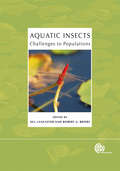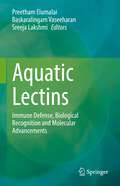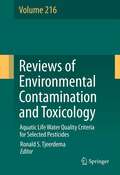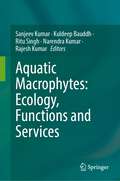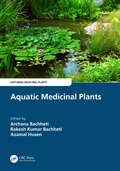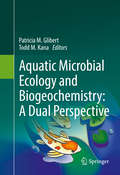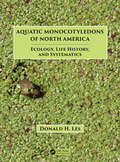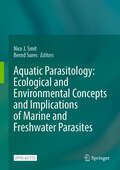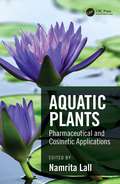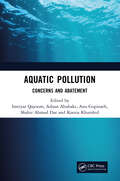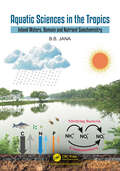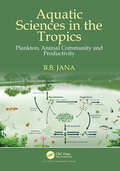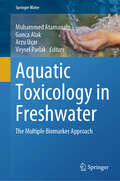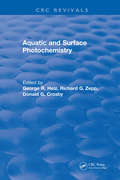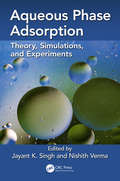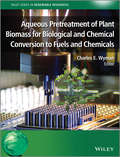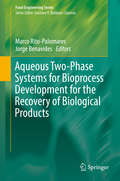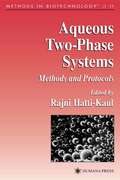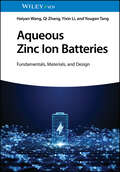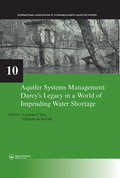- Table View
- List View
Aquatic Insects: Proceedings of the Royal Entomological Society’s 24th Symposium
by Jill Lancaster Robert A. BriersThis edited volume brings together acknowledged experts in often disparate fields ranging from physiology through ecology to evolution to consider in a unified manner the challenges facing insect populations in aquatic environments and how they have adapted to achieve such prominence in virtually all habitats.
Aquatic Lectins: Immune Defense, Biological Recognition and Molecular Advancements
by Preetham Elumalai Sreeja Lakshmi Baskaralingam VaseeharanThis book provides the latest information on fish lectins from the perspective of inflammation and presents new ideas on the complicated mechanisms of lectin biochemistry and associated interactions. Key features include discussion of mechanisms recently identified to be involving lectin family types, presentation of the latest evidence regarding the molecular approaches in fish lectins, and thorough explanation of the concept of antimicrobial and immunological roles and current understanding of the significance of its disease resistance related studies. Gene expression studies is another important element of the book, and it is proposed that gene editing technology provides gaining attention in the biological role of fish lectin research. Examples of the many lastest molecular approaches, applications and future perspectives in fish lectin specific topics covered in this book include the information right from the basics to the advancements in this area. The book will be a valuable update and resource for both experienced and younger researchers working in the field of lectins and immunology.
Aquatic Life Water Quality Criteria for Selected Pesticides (Reviews of Environmental Contamination and Toxicology #216)
by Ronald S. TjeerdemaReviews of Environmental Contamination and Toxicology attempts to provide concise, critical reviews of timely advances, philosophy and significant areas of accomplished or needed endeavor in the total field of xenobiotics, in any segment of the environment, as well as toxicological implications.
Aquatic Macrophyte Risk Assessment for Pesticides
by Dave Arnold Jo Davies Fred Heimbach Lorraine Maltby Gertie Arts Christina Pickl Veronique PoulsenGiven the essential role that primary producers play in aquatic ecosystems, it is imperative that the potential risk of pesticides to the structure and functioning of aquatic plants is adequately assessed. An integration of regulatory and research information from key specialists in the area of environmental regulation, Aquatic Macrophyte Risk Asse
Aquatic Macrophytes: Ecology, Functions and Services
by Narendra Kumar Kuldeep Bauddh Sanjeev Kumar Rajesh Kumar Ritu SinghThis book is a comprehensive collection of information about the features, functions, and services of aquatic macrophytes. As primary producers, aquatic macrophytes form the basis of food webs, play a major role in highly productive aquatic ecosystems, and have a significant impact on ecosystem functions and services. Macrophytes are also known to strongly influence the micro-climate and biogeochemical processes occurring in the littoral zones of marine ecosystems and the sediment dynamics of freshwater systems. They also serve as highly effective carbon sinks and play an important role in carbon sequestration. This book deals with various aspects of aquatic macrophytes, including nutrient recycling, biogeochemical processes, biomass production, wetland ecosystems, water resource management, carbon sequestration, environmental clean-up, and bioenergy production. Additionally, it presents the current status of aquatic macrophytes and discusses the impact of climate change on these plants. The book also highlights the major challenges associated with harnessing the benefits provided by aquatic macrophytes as ecosystem services. The book holds value and relevance for academicians and scientists working in the related domain. Additionally, it will serve as a valuable resource for students and researchers working in the field of ecology, biogeochemistry, wetland conservation, phytoremediation, elements biomonitoring, wastewater management, bioenergy production, etc.
Aquatic Medicinal Plants (Exploring Medicinal Plants)
by Azamal Husen Rakesh Kumar Bachheti Archana BachhetiThe use of medicinal plants in herbal and modern medicine has gained popularity over the last few decades due to consumers taking more natural approaches to medicine. Aquatic medicinal plants are rich in bioactive compounds and demonstrate various commercial, nutraceutical, and biological applications. Aquatic Medicinal Plants offers the reader a wealth of information on uses of bioactive components of these plants, along with crucial references, and explains their traditional uses, phytochemistry, and pharmacological properties.Features Provides information on aquatic and semiaquatic medicinal plants and their uses globally. Discusses phytochemical components with the known active constituents and their pharmaceutical applications. This volume in the Exploring Medicinal Plants series is appropriate for scientists, experts, and consultants associated with the exploration of aquatic medicinal plant usage. This book is an essential tool for identifying important aquatic medicinal plants and possibilities for the synthesis or preparation of modern drugs.
Aquatic Mesocosm Studies in Ecological Risk Assessment
by Robert L. GraneyA Special Publication of the Society of Environmental Toxicology and Chemistry (SETAC)Aquatic Mesocosm Studies in Ecological Risk Assessment discusses the methods currently used for conducting simulated field studies and provides a series of case histories in which mesocosm type studies have been used to assess the impact of pesticides on aquatic ecosystems. Specific chapters address the dosing and exposure components of such studies and how they influence experimental design. Advantages and disadvantages of various statistical designs are addressed in detail. Regulatory aspects of the design and interpretation of these studies are also covered. The book will be a superb reference for aquatic biologists, ecologists, toxicologists, environmental toxicologists, environmental chemists, and regulatory personnel.
Aquatic Microbial Ecology and Biogeochemistry: A Dual Perspective
by Patricia M. Glibert Todd M. KanaThis book highlights perspectives, insights, and data in the coupled fields of aquatic microbial ecology and biogeochemistry when viewed through the lens of collaborative duos - dual career couples. Their synergy and collaborative interactions have contributed substantially to our contemporary understanding of pattern, process and dynamics. This is thus a book by dual career couples about dual scientific processes. The papers herein represent wide-ranging topics, from the processes that structure microbial diversity to nitrogen and photosynthesis metabolism, to dynamics of changing ecosystems and processes and dynamics in individual ecosystems. In all, these papers take us from the Arctic to Africa, from the Arabian Sea to Australia, from small lakes in Maine and Yellowstone hot vents to the Sargasso Sea, and in the process provide analyses that make us think about the structure and function of all of these systems in the aquatic realm. This book is useful not only for the depth and breadth of knowledge conveyed in its chapters, but serves to guide dual career couples faced with the great challenges only they face. Great teams do make great science.
Aquatic Monocotyledons of North America: Ecology, Life History, and Systematics
by Donald H. LesThis book brings together information on the natural history, ecology and systematics of North American aquatic monocotyledons. The book is an overview of the biology of major aquatic species by compiling information from numerous sources that lie scattered among the primary literature, herbarium databases, and other reference sources. Information on more than 300 species in 87 genera of monocotyledons will be included. Recent phylogenetic analyses will be incorporated. Although focusing specifically on North America, the cosmopolitan distribution of many aquatic plants should make this an attractive text to people working virtually anywhere outside of the region as well. Key Selling Features: The primary source of natural history information on aquatic plants Comprehensive lists of ecological associates Synthetic overview of systematic relationships of aquatic species and genera Practical information for rare and invasive plant managers Essential guide to facilitate wetland delineation
Aquatic Organic Matter Fluorescence
by Paula G. Coble Jamie Lead Andy Baker Darren M. Reynolds Robert G. M. Spencer Paula G. Coble Jamie Lead Andy Baker Darren M. ReynoldsThis is the first comprehensive text on the theory and practice of aquatic organic matter fluorescence analysis, written by the experts who pioneered the research area. This book covers the topic in the broadest possible terms, providing a common reference for making measurements that are comparable across disciplines, and allowing consistent interpretation of data and results. The book includes the fundamental physics and chemistry of organic matter fluorescence, as well as the effects of environmental factors. All aspects of sample handling, data processing, and the operation of both field and laboratory instrumentation are included, providing the practical advice required for successful fluorescence analyses. Advanced methods for data interpretation and modeling, including parallel factor analysis, are also discussed. The book will interest those establishing field, laboratory, or industrial applications of fluorescence, including advanced students and researchers in environmental chemistry, marine science, environmental geosciences, environmental engineering, soil science, and physical geography.
Aquatic Parasitology: Ecological and Environmental Concepts and Implications of Marine and Freshwater Parasites
by Nico J. Smit Bernd SuresThis open access volume is the first to provide a comprehensive overview of the ecological and environmental characteristics of marine and freshwater parasites. In three clearly organized sections, world-leading authors present the current state of our knowledge as well as the future trends for their respective fields in aquatic parasitology. First, the basic life cycle strategies of the various major groups of aquatic parasites are presented, including protists, myxozoa, aquatic fungi, helminths, and arthropods. Subsequent chapters explore the ecological implications of aquatic parasites covering topics such as biodiversity, evolution, community structures, behavior, and conservation - to name a few. In addition, important developments in research are presented, such as the use of different molecular tools and eDNA in aquatic parasitology. The final section is devoted to the new field of environmental parasitology, where readers will find contributions on biological markers, invasive species, and bioindicators of environmental pollution, among others. Due attention is also given to zoonoses, aquaculture, and the effects of climate change on aquatic parasites. All chapters include original high-quality illustrations and never-before-seen photographs which complement the diverse aspects of aquatic parasitology described. Thus, this book is a must for every parasitologist and ecologist.
Aquatic Physiosphere-Biosphere Dynamics and Modelling: A Reference for Studies of the Coupled System
by Aike BeckmannThis encyclopedia is a reference for aquatic physical, biological and biogeochemical sciences, collecting and connecting a number of topics, concepts and facts about aquatic systems and their scientific investigation. The scope of the book comprises the aquatic physiosphere-biosphere transition zone, an entity that encompasses both inanimate matter and collectives (the physiosphere) as well as living organisms and collectives (the biosphere). This combined approach is meaningful because both realms are intimately linked and because available methods of investigation are often similar. Much can be gained from considering both spheres at and across their interface jointly, and while there is a strong focus on marine systems, most concepts presented are also applicable to freshwater systems. This presented snapshot of knowledge of the transition zone between the aquatic physiosphere and biosphere is taken from a very specific angle: the point of view of a modeler. Modeling is not only a state-of-the-art mode of scientific investigation, but also requires the explicit specification of all assumptions (helping to avoid fallacies), and offers the advantage of being quantitative and allows for theoretical "what if" scenarios.As in any reference work, equal emphasis is given to fundamental facts, the definition of terms and the explanation of concepts, in an attempt to establish a joint language for physicists, biologists and biogeochemists. Although originating from a modeler's approach to nature, the resulting suite of compatible concepts may also be useful beyond modeling purposes. Furthermore, the material is presented in a condensed, straightforward way. Hence, the length of each entry is limited to one (occasionally two) pages, thus offering a quick introductory overview. This excludes lengthy derivations and very specialized details. The book is geared towards researchers, teachers and advanced students in the field of aquatic (marine and limnic) sciences, in particular those interested or involved in interdisciplinary work.
Aquatic Plants of Pennsylvania: A Complete Reference Guide
by Timothy A. Block Ann Fowler RhoadsFrom the Delaware River to the shores of Lake Erie, Pennsylvania's diverse watery habitats are home to more than 200 species of aquatic plants. In Aquatic Plants of Pennsylvania: A Complete Reference Guide, botanists Timothy A. Block and Ann Fowler Rhoads have assembled the first identification guide specific to the Keystone State yet useful throughout the Mid Atlantic region. Organized and written in a way that will make information easily accessible to specialists and nonspecialists alike, the book highlights the diversity and vital ecological importance of this group of plants, providing photographs, illustrations, descriptions, and identification keys for all emergent, floating-leaved, and submergent aquatic plants found in the Commonwealth.An introductory chapter on aquatic plant ecology covers topics such as evolution, form, and reproduction of aquatic plants, vegetation zones, types of aquatic ecosystems, and rare and endangered species. Information on invasive plants, such as Eurasian water-milfoil and curly pondweed, that threaten Pennsylvania's aquatic ecosystems will be especially useful to watershed organizations, citizen monitoring projects, lake managers, and natural resource agency personnel. An illustrated identification key guides the reader through a series of steps to properly identify a specimen based on its characteristics. Each of the more than 200 listings provides a plant's taxonomy, detailed description, distribution map, and expert botanical illustrations. Many also include color photographs of the plants in their natural habitats.
Aquatic Plants: Pharmaceutical and Cosmetic Applications
by Namrita LallAquatic Plants: Pharmaceutical and Cosmetic Applications provides a concise description of popular aquatic plants found across the globe. The chapters in this beautifully illustrated, full-color book focus on the aquatic species native to specific continents. Written by a global team of experts, this book explains the distribution, ethnobotanical uses, genome sequencing, chemical compounds, and biological activity of these plants and addresses the cultivation and sustainable production of aquatic and wetland plants. Features: Describes the biological activity of a large collection of aquatic plants. Color photographs highlight each plant’s ethnobotanical characteristics, and structural formulae show their chemical constituents. Contributions come from leading scientists from countries including the United States, India, Mauritius, South Africa, and Cyprus. Aquatic Plants: Pharmaceutical and Cosmetic Applications is a valuable resource for academics conducting research on aquatic plants and for professionals in the pharmaceutical and cosmetic industries who are involved with the therapeutic applications of these plants and their sustainable usage.
Aquatic Pollution: Concerns and Abatement
by Imtiyaz Qayoom Adnan Abubakr Anu Gopinath Shabir A. Dar Keezia KhurshidThis book discusses the sources, mechanism, impact and abatement of pollution in waterbodies and lays a base foundation for further research. In this book, readers will also get acquainted with the methods of decontamination of lakes by phytoremediation, pesticide removal techniques from lakes, toxic site reclamation and environmental sustainability using microbial aspects associated with clean-up of wastes.Based on the issues related to pollution of aquatic environments, the subject matter of this book includes: Nanoplastic Pollutants Affecting Fisheries Sector All Over the World Freshwater Floral Diversities as Pollution Indicators Radioactive Waste: Sources and Impact on Environment Environmental Sustainability Using Microbial Aspects Associated With Clearing Up Waste Nitrates and Phosphates: Boon or Bane for Waterbodies Print edition not for sale in South Asia (India, Sri Lanka, Nepal, Bangladesh, Pakistan and Bhutan)
Aquatic Sciences in the Tropics: Inland Waters, Domain and Nutrient Geochemistry
by B.B. JanaThe tropical environment is unique due to its geographic location, climatic features, intense solar radiation, high temperature, heavy precipitation, less seasonal variation, enhanced food and productivity, faster metabolism, ecological dynamics and co-evolutionary processes that favor niches for specialized species. It also provides the richest biodiversity with endemic fish species that support millions of people in rural areas. This book Aquatic Sciences in the Tropics: Inland Waters, Domain and Nutrient Geochemistry comprises nine primary chapters that address various topics. Chapter 1 covers topics such as Water as a Substance, Water as a Medium, Fundamentals of Global Water Distribution and Hydrologic Cycle, Economics of Water and Challenges; Chapter 2: The Environment, Tropical Environment, Concept of Biosphere and Aquatic Biome, Tropical Aquatic Bionetwork, Tropical Limnology; Chapter 3: Origin of Lakes, General Classification of Lakes, Tropical Lakes, Lake Morphometry, Morpho-Edaphic Index, Trophic State Index of Lakes, Wetlands, Mangroves; Chapter 4: Concept of Stream Order, Streams and Rivers, The River Continuum Concept, Physico-chemical and Biological Features of Streams, Adaptations of Hill Stream Fishes; Chapter 5: Light as an Entity, Thermal Regime, Thermal Stratification, Lake Mixing, Turnover and Circulation; Chapter 6: Sources of CO2 in Inland Waters, Hydrogen Ion Concentration, The CO2–CO3–HCO3 System, Alkalinity, Hardness; Chapter 7: Dissolved Oxygen, Oxidation and Reduction Potential; Chapter 8: Total Dissolved Solids, Dissolved Organic Carbon; Chapter 9: Origin of Atmospheric Gases, Carbon and Carbon Cycle, Nitrogen, Nitrogen Fixation, Ammonification, Nitrification and Comammox, Denitrification and Anammox, Phosphorus and Sulphur.It is anticipated that the academic community, students, teachers, instructors, researchers, colleges, universities, institutions, administrators, policy makers, public libraries and the general public with an interest in these topics will find this text to be a valuable source of information and provide in-depth knowledge.
Aquatic Sciences in the Tropics: Plankton, Animal Community and Productivity
by B. B. JanaThe anatomy of water, water as a substance, water as a medium, the principles of the hydrologic cycle, the economics of water, and challenges are all covered in the first chapter of this book. The horizon of the tropical world, the environment, particularly the tropical environment, aquatic biome, tropical aquatic bionetwork, concept of biosphere, and tropical limnology are all covered in the second chapter. The third chapter covers the following topics: the origins of lakes, general lake classification, tropical lakes, lake morphometry, morpho-edaphic index, trophic status index of lakes, wetlands, and mangroves in tropical regions. The lotic environment is the main topic of the fourth chapter, which also covers the idea of stream order, the differences between rivers and streams, the river continuum, physical, chemical, and biological characteristics, and adaptations of fish found in hill streams. Chapter five covers the prokaryota, cyanobacteria, freshwater biota, and water-adapted organisms. The sixth chapter focuses on the algal communities Xanthophyceae, Euglenophyceae, Bacillariophyceae, Chrysophyceae, Phaeophyceae (brown algae), and Chlorophyceae. The seventh and last chapter covers the following topics: Protozoa, Porifera, Rotifera, Coelenterata, Annelida, Arthropoda, Crustacea, Aquatic Insects, Mollusca, Echinodermata, and Brachiopodaa.
Aquatic Toxicology in Freshwater: The Multiple Biomarker Approach (Springer Water)
by Muhammed Atamanalp Gonca Alak Arzu Uçar Veysel ParlakThis book will provide an important source of practical information on the history of toxicology, the ways in which pollutants reach model organisms used in toxicology, sampling methods for research, mechanisms of toxicity and responses of aquatic organisms to toxic agents, as well as the use of therapeutic agents in current approaches. Determining the importance of environmentally friendly substances on antioxidant defense is an obvious area of future research.The combined use of a biomarkers range that can indicate exposure to pollutants and measure their effects on living organisms enables a more comprehensive and integrative assessment of indicator organisms in the aquatic environment, both biochemically and cellularly. In conclusion, the multiple biomarker approach had received great interest in ecotoxicological research and had recently been adapted to both field and laboratory studies.
Aquatic and Surface Photochemistry
by George R. HelzAquatic and Surface Photochemistry provides a broad overview of current research in the emerging field of environmental aquatic and surface photochemistry. Selected reviews and current research articles are blended to provide an in-depth treatment of various aspects of this research area. The first part of the text deals with photochemistry in the environment, covering recent research on the following topics: aquatic photochemistry of organic pollutants and agrochemicals, photochemical cycling of carbon and transition metals (especially iron), photochemical formation of reactive oxygen species in natural waters, photoreaction in cloud and rain droplets, and photoreactions on environmental surfaces (soil, ash, metal, oxide). The second part provides discussions and data on both heterogeneous photocatalytic and homogeneous processes, with topics ranging from applications to mechanistic studies. These chapters illustrate the wide diversity of pollutant classes that are degradable by photochemical techniques and the effects of various reaction conditions on the rates and efficiency of the techniques. Current kinetic studies are presented, which provide new information about the role of adsorption and the nature of the reactive oxidizing species that mediate these photoremediation processes.This book will interest civil, chemical, and environmental engineers, as well as chemists, soil scientists, geochemists, and atmospheric chemists.
Aqueous Phase Adsorption: Theory, Simulations and Experiments
by Nishith Verma Jayant SinghThis book covers theoretical aspects of adsorption, followed by an introduction to molecular simulations and other numerical techniques that have become extremely useful as an engineering tool in recent times to understand the interplay of different mechanistic steps of adsorption. Further, the book provides brief experimental methodologies to use, test, and evaluate different types of adsorbents for water pollutants. Through different chapters contributed by accomplished researchers working in the broad area of adsorption, this book provides the necessary fundamental background required for an academician, industrial scientist or engineer to initiate studies in this area. Key Features Explores fundamentals of adsorption-based separation Provides physical insight into aqueous phase adsorption Includes theory, molecular and mesoscopic level simulation techniques and experiments Describes molecular simulations and lattice-Boltzmann method based models for aqueous phase adsorption Presents state-of-art experimental works particularly addressing removal of "emerging pollutants" from aqueous phase
Aqueous Pretreatment of Plant Biomass for Biological and Chemical Conversion to Fuels and Chemicals
by Charles E. WymanPlant biomass is attracting increasing attention as a sustainable resource for large-scale production of renewable fuels and chemicals. However, in order to successfully compete with petroleum, it is vital that biomass conversion processes are designed to minimize costs and maximize yields. Advances in pretreatment technology are critical in order to develop high-yielding, cost-competitive routes to renewable fuels and chemicals.Aqueous Pretreatment of Plant Biomass for Biological and Chemical Conversion to Fuels and Chemicals presents a comprehensive overview of the currently available aqueous pretreatment technologies for cellulosic biomass, highlighting the fundamental chemistry and biology of each method, key attributes and limitations, and opportunities for future advances.Topics covered include:* The importance of biomass conversion to fuels* The role of pretreatment in biological and chemical conversion of biomass* Composition and structure of biomass, and recalcitrance to conversion* Fundamentals of biomass pretreatment at low, neutral and high pH* Ionic liquid and organosolv pretreatments to fractionate biomass* Comparative data for application of leading pretreatments and effect of enzyme formulations* Physical and chemical features of pretreated biomass* Economics of pretreatment for biological processing* Methods of analysis and enzymatic conversion of biomass streams* Experimental pretreatment systems from multiwell plates to pilot plant operations This comprehensive reference book provides an authoritative source of information on the pretreatment of cellulosic biomass to aid those experienced in the field to access the most current information on the topic. It will also be invaluable to those entering the growing field of biomass conversion.
Aqueous Two-Phase Systems for Bioprocess Development for the Recovery of Biological Products (Food Engineering Series)
by Marco Rito-Palomares Jorge BenavidesThis comprehensive and unique text presents a full overview of downstream processing useful for those new to the concept as well as professionals with experience in the area. The history and theoretical principles of Aqueous Two-Phase Systems (ATPS) are covered in depth. Information on ATPS characterization and application is included, and ATPS equilibria and system parameters that have significant effect on partition behavior are studied. Aqueous Two-Phase Systems for Bioprocess Development for the Recovery of Biological Products addresses specific applications of ATPS for the recovery and partial purification of high molecular weight compounds such as proteins, nucleic acids and polysaccharides, particulate bioproducts such as cells and organelles and low molecular weight compounds. Non-conventional strategies involving ATPS such as affinity systems, continuous liquid-liquid fractionation stages and the recovery from plant extracts are presented. Economic analysis of the application of ATPS in comparison to other fractionation techniques, particularly liquid chromatography, is considered, as are opportunity and current trends in the ATPS research area. Each chapter utilizes the contributors' experimental expertise in traditional and non-conventional ATPS strategies, as well as analysis of areas of opportunity and perspectives on the development and future applications of ATPS in both the lab and larger scale operations. The result is a thorough and singular overview of ATPS which has not been matched by any other text on the market.
Aqueous Two-Phase Systems: Methods and Protocols (Methods in Biotechnology #11)
by Rajni Hatti-KaulRajni Hatti-Kaul and her expert coauthors combine theory, methodology, and applications in a practical collection of easily reproducible protocols for bioseparations in aqueous two-phase systems (ATPS). The protocols range from established methods to cutting-edge techniques with potential biotechnological applications. Among the methods detailed are those for ATPS preparation and characterization, for partitioning applied to soluble molecules and particulates (including whole cells, membranes, and organelles), and for the isolation and purification of proteins-including a glimpse of large-scale handling of two-phase separations. Practical and informative, with its detailed guidelines allowing researchers to adapt specific systems to their own separation needs, Aqueous Two-Phase Systems: Methods and Protocols demonstrates the scope and utility of two-phase aqueous systems in both basic and applied research.
Aqueous Zinc Ion Batteries: Fundamentals, Materials, and Design
by Haiyan Wang Qi Zhang Yougen Tang Yixin LiAqueous Zinc Ion Batteries Pioneering reference book providing the latest developments and experimental results of aqueous zinc ion batteries Aqueous Zinc Ion Batteries comprehensively reviews latest advances in aqueous zinc ion batteries and clarifies the relationships between issues and solutions for the emerging battery technology. Starting with the history, the text covers essentials of each component of aqueous zinc ion batteries, including cathodes, anodes, and electrolytes, helping readers quickly attain a foundational understanding of the subject. Written by three highly qualified authors with significant experience in the field, Aqueous Zinc Ion Batteries provides in-depth coverage of sample topics such as: History, main challenges, and zinc metal anodes for aqueous zinc ion batteriesElectrochemical reaction mechanism of aqueous zinc ion batteries and interfacial plating and stripping on zinc anodesCathode materials for aqueous zinc ion batteries, covering manganese-based materials, vanadium-based materials, Prussian blue analogs, and other cathode materialsDevelopment of electrolytes, issues, and corresponding solutions for aqueous zinc ion batteries Separators for aqueous zinc ion batteries, development of full zinc ion batteries, and future perspectives on the technology A detailed resource on a promising alternative to current lithium-ion battery systems, Aqueous Zinc Ion Batteries is an essential read for materials scientists, electrochemists, inorganic chemists, surface chemists, catalytic chemists, and surface physicists who want to be on the cutting edge of a promising new type of battery technology.
Aquifer Systems Management: Selected Papers on Hydrogeology 10 (IAH - Selected Papers on Hydrogeology)
by Laurence Chery Ghislain De MarsilyPresented at the International Association of Hydrogeologists Dijon Symposium, this book contains 43 selected papers, grouped into six topics, that address the following issues: large aquifers, resource assessment; large aquifers, water salinity and evolution; karstic and carbonate aquifer systems; geothermal aquifer systems; aquifer contamination studies; and aquifer monitoring systems and management. In celebration of the 150th anniversary of the publication of Darcy's Law, the volume includes a summary of Darcy's life and his contribution to science, and five invited contributions on modern methods to estimate the hydraulic conductivity of aquifers.
